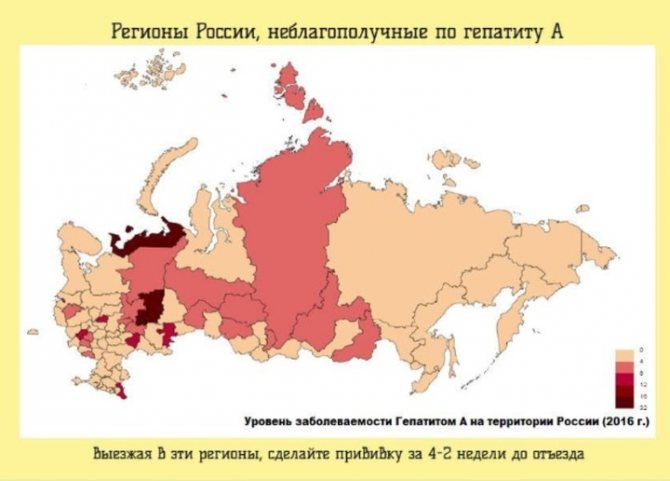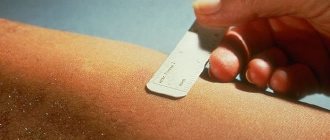What else are there vaccinations for?
Vaccinations exist for many diseases, but in our country the most relevant are the following.
Flu
Getting a flu vaccine every year reduces your chances of getting it. Many people think that this vaccine is useless because the virus mutates quickly. But everything is much more complicated. In this arms race, there are special forecasting tools with which you can quite accurately predict the structure of the virus in the new season and create a new, relevant vaccine every year.
Whooping cough
Vaccination against whooping cough for adults in our country, and in the world, became available not so long ago. Previously, it was believed that adults do not get whooping cough, only children. But it turned out that this was not the case. It’s just that in adults it often occurs in a mild form, and no diagnosis is made. Such a person can be a source of infection for others, for example, for his own newborn child. We received our last whooping cough vaccine when we were about one and a half years old, and in adulthood we no longer have immunity to this infection. In certain life situations, which will be discussed below, vaccination may be justified. Vaccination against whooping cough is not included in the national calendar; the Adasel vaccine is the only vaccine for adults available in the Russian Federation, and only at its own expense.
Chicken pox
If you have not had chickenpox, it is better to get vaccinated. Ten years ago there was no way to protect against this infection in Russia, since there was no such vaccine in the country; it is relatively new. We also do not carry out mass vaccination of children against this infection, so the chance of encountering it, especially if you have children, is very, very high. In adults, chickenpox is more severe than in children, so there is a chance to reduce your risk of getting sick to almost zero.
Hepatitis A
The hepatitis A vaccination is included in the calendar for epidemic reasons, which means that not everyone gets it. But any adult can do it if they wish, since jaundice is also not very pleasant. This vaccine is especially indicated for some people. Those who have an occupational risk of infection are subject to vaccination:
- medical workers;
- public service workers;
- employed at food industry enterprises;
- workers maintaining water supply and sewerage facilities, equipment and networks.
Also at increased risk of infection are:
- military personnel traveling to areas with high incidence rates;
- employees of educational institutions;
- staff involved in patient care.
If someone in your family falls into these groups, the risk for the rest of the family also increases, and it would be wise to get vaccinated.

Tick-borne encephalitis
This is a viral infection transmitted by ticks. Widely distributed in Russia, Europe and the USA, but not everywhere. If you permanently live in an endemic area, then vaccination can protect you. There is no cure for this disease, and the consequences can be very dire, so it depends on your luck.
We have never heard of many vaccines, such as against plague, dysentery, typhus and others, since they are not typical for our region, but can be useful when traveling abroad.
A number of other vaccines, such as vaccinations against pneumococcal, meningococcal, and Haemophilus influenzae infections, are important for certain groups of people at increased risk and are not recommended for mass vaccination.

Vaccination calendar for children under 1 year of age
Children under the age of 1 year are vaccinated against tuberculosis, viral hepatitis B, pneumococcal infection (Previnar, Synflorix vaccination); against whooping cough, diphtheria, tetanus and polio (as part of complex vaccines - Pentoxin, Infantrix Hexa, etc.), hemophilus influenzae infection (included in complex vaccines).
Vaccination against rotavirus gastroenteritis is carried out with the Rotatek vaccine, and against meningococcal infection with the Menactra vaccine (from 9 months).
The Rotatek and Menactra vaccines are not included in the national calendar. Vaccination against influenza according to epidemic indications begins at the age of 6 months.
Vaccine options
Diphtheria vaccines are based on diphtheria toxoid, which is a modified bacterial toxin that induces a protective antitoxin. The diphtheria vaccine is a toxoid adsorbed on aluminum hydroxide. Diphtheria toxoid is also produced in combination with tetanus toxoid (ADS, ADS-m vaccinations) and pertussis vaccine (whole cell - DPT, Bubo-M, Bubo-Kok; and acellular or acellular - Infanrix, Pentaxim, Tetraxim, Infanrix Penta, InfanrixHexa) . Preventive vaccinations allow you to create long-term and intense antitoxic immunity against diphtheria.
The DTP vaccination consists of a mixture of corpuscular pertussis vaccine, diphtheria and tetanus toxoids. ADS toxoid is purified and adsorbed diphtheria and tetanus toxoids. ADS-M-toxoid differs from ADS in its reduced antigen content - one vaccination dose (0.5 ml) contains 5 LF (a unit of measurement of the activity of components) of diphtheria toxoid and 5 EC (a unit of measurement of the activity of components) of tetanus toxoid (for comparison, 0 .5 ml of ADS vaccination contains 30 LF of diphtheria toxoid and 20 EC of tetanus toxoid).
All vaccines for the prevention of diphtheria, tetanus and whooping cough are inactivated (killed), that is, they do not contain anything living. It is known that individual antigens in their pure form and inactivated vaccines are inferior in effectiveness to live vaccines. In this regard, aluminum hydroxide is used as an amplifier (so-called adjuvant) for vaccination against diphtheria, tetanus, whooping cough (and a number of other infections). The point of using this substance is to enhance the inflammatory reaction at the site of vaccine administration and, as a result, intensify immune reactions and increase the effectiveness of vaccination in general.
Vaccinations "Pentoxin", DTP, ADS-M, ADS, "Infantrix Hexa"
Parents ask to decipher the abbreviation, ADS-M, ADS, “Infantrix hexa”. These are complex vaccinations against whooping cough and diphtheria (DPT, Infantrix). Against whooping cough, diphtheria, tetanus, polio and hemophilus influenzae - Pentoxim and Infantrick Hexa (the latter also includes vaccination against hepatitis B). These immunotherapy drugs are used to vaccinate children under 1 year of age 3 times, followed by revaccination a year later.
According to an individual schedule, it is allowed to vaccinate children with the Pentoxim and Infantrick Hexa vaccines up to 6 years of age, and with the DTP vaccine up to 4 years of age. The ADS and ADS-M vaccines are directed against diphtheria and tetanus. ADS is usually used for children under 6 years of age (two-time vaccination + revaccination) who have had whooping cough. ADS-M is used for routine revaccination of children at 7 and 14 years of age, adults - every 10 years. This “weakened” version of the ADS vaccine is also used to vaccinate children with chronic pathology.
Tolerability of DPT vaccine by children
Parents are often interested in the issue of vaccine tolerability.
The DTP vaccine has a high degree of protection against whooping cough, but it is more reactogenic than similar vaccines “Pentoxim”, “Infantrix Hexa”, since the pertussis component in DTP is whole-cell. For diphtheria and tetanus, the difference between the vaccines is insignificant.
Before DTP vaccination, the child must be healthy for at least 3–4 weeks without signs of residual manifestations of the disease. Before consulting a doctor, it is necessary to do a clinical blood and urine test.
Diagnostics
Diphtheria is dangerous due to severe complications, so it is very important to immediately seek medical help when the first signs of the disease appear. Timely diagnosis of the disease and administration of appropriate treatment minimizes the risk of developing undesirable consequences for the body.
Diphtheria is diagnosed through an external examination by a doctor and laboratory tests.
During the examination, the specialist pays attention to the patient’s complaints, history of the onset of the disease, and external signs of its manifestation. The membranous variant of diphtheria is easier to diagnose by the presence of fibrinous plaque
The signs of island diphtheria of the oropharynx, for example, are almost identical to tonsillitis of coccal etiology and necrotic nature or candidiasis. The toxicity and type of pathogen will be determined by bacteriological cultures of discharge from inflammation. And the degree of intoxication of the body is determined by laboratory analysis of blood parameters.
Vaccination "Prevenar"
"Prevenar" is a vaccine against pneumococcal infection, protects against pneumonia, pneumococcal meningitis, and sepsis. It is included in the National Preventive Vaccination Calendar. Vaccination is done depending on age 1 - 3 times (+ - revaccination) as prescribed by the doctor.
A child is vaccinated from 2 months of age, since particularly severe forms of pneumococcal infection occur in infants. The vaccine is also indicated for older and immunocompromised people to prevent severe, fatal pneumonia.
The Synflorix vaccine is similar. The Pneumo-23 (Pneumovax-23) vaccination is more indicated for those who are often ill and is given from 2 years of age.
Hepatitis B vaccinations
Vaccination against hepatitis B can be either monovalent (hepatitis B only) or included in complex preparations (Infantrix Hexa). The vaccination is done three times, starting at the maternity hospital.
When vaccinated at an early age, protection against hepatitis B lasts for 18 years.
In adults, vaccination is always carried out three times every 5 - 7 years, which is due to the peculiarity of the immune defense in adults.
Vaccinations against hepatitis B (single and complex vaccines) are generally well tolerated by patients.
Vaccination against hepatitis A (Botkin's disease) is done from the 1st year twice with an interval of 6 months according to epidemic indications.
How long should you not wash after a tetanus shot?
Bathing and walking after vaccination
popular questions among parents. Doctors usually do not recommend bathing a child on the day of vaccination and 2 days after, the same applies to walks.
Such recommendations are due to the fact that the introduction of some vaccines may develop a vaccine reaction. The child's temperature may rise, and if the body temperature is elevated, swimming and walking are not recommended.
But vaccinations are different and reactions to them develop at different times.
Bathing and walking after vaccination against diphtheria, whooping cough and tetanus
Most often, a temperature reaction develops to vaccination against whooping cough, diphtheria and tetanus. Moreover, most often, with the introduction of the domestic DTP vaccine, but with the introduction of imported vaccines: Pentaxim and Infanrix, a reaction to the vaccine is also possible.
The temperature after vaccination against whooping cough, diphtheria and tetanus most often rises and reaches a maximum in the first 24 hours after vaccination, then it begins to decrease, usually the body temperature after vaccination normalizes within 72 hours. It is after this vaccination that it is not recommended to bathe with the child on the day of vaccination and 2 days after.
If a child’s temperature rises above 38 C, it is necessary to give the child an antipyretic and provide him with a gentle regimen so as not to provoke the development of a viral or bacterial infection during this period.
Even if you think that your child tolerates all vaccinations well and there is no risk of fever, it is better not to swim or go for a walk on the day of vaccination.

Some mothers believe that if the child tolerated the first vaccination against diphtheria, whooping cough and tetanus well, the same will happen after all subsequent vaccinations. This opinion is wrong. The reaction to vaccination against whooping cough, diphtheria and tetanus may increase, for example: after the first vaccination there is no fever, after the second - a slight one, after the third - 38 C, most often reactions are observed on the fourth vaccination, because antibodies to the components accumulate in the child’s body vaccines. Therefore, you should not neglect medical recommendations; the child can do without baths and walks for 1-3 days.
After hepatitis vaccination
After vaccination against hepatitis, there are practically no temperature reactions, so the child can be bathed and walked with him on the same day.
Vaccination against polio
Imovax or inactivated polio vaccine practically does not cause temperature reactions, so when it is carried out separately from other vaccinations, there are no restrictions on swimming and walking.
The same applies to the oral polio vaccine, in addition, reactions to this vaccine are checked at different times.
Vaccination against measles, mumps and rubella
A reaction to these vaccines is possible 10-14 days after vaccination, so immediately after vaccination there are no restrictions on walking and swimming. and then you should focus on the child’s well-being.
Flu shot
The reaction to this vaccine, as well as to the vaccine against whooping cough, diphtheria and tetanus, develops in the first 72 hours. But it is most often given to children older than one year and adults; it is impossible not to go for walks here, so it is recommended that in the first days after vaccination, limit physical activity, exercise in the pool, and do not swim for 1-2 days after vaccination (then depending on your well-being).
BCG vaccination
The BCG vaccination is most often done in the maternity hospital. The vaccine is administered intradermally into the left shoulder area. It is recommended not to bathe the child only on the day of vaccination; further bathing is possible, but the vaccination site must be protected from mechanical irritation #8211; Do not rub with a washcloth until a scar forms. Getting water into the grafting site is not dangerous. There are no restrictions on walking.
Mantoux reaction and Diaskintest
These are not vaccinations, but skin tests. Usually mothers are afraid to wet the injection site. Getting water into the injection site is not dangerous, the main thing is not to rub (with a towel, washcloth), or scratch. Swimming before checking the reaction is not recommended, just in case #8211; Suddenly, while swimming, you forget and rub the injection site.
I hope you found in the article the answer to the question of when you can walk and bathe your child after vaccination.
13.07. | Admin | View 72 | Comm. x | Category: Interesting
No comments yet!
Vaccinations against meningococcal infection (meningococcal meningitis, meningococcemia)
Vaccination against meningococcal infection (meningococcus groups W-135, C, Y, A).
The vaccine is administered to adults and children from 9 months. Up to 2 years of age, children are vaccinated twice with an interval of 3 months; from 2 years – 1 time. The vaccine is well tolerated and protects for life.
In children's groups, during outbreaks of meningococcal disease, a polysaccharide meningococcal vaccine can be used, which provides protection for 3 years.
You can read more about this vaccination in a separate article.
Chickenpox vaccination
The purpose of vaccination is to prevent chickenpox primarily in individuals classified as high-risk groups who have not had chickenpox and have not been previously vaccinated.
The vaccine is also used for emergency prevention of chickenpox in persons who have not been sick and have not been vaccinated before, and who are in close contact with patients with chickenpox; the vaccine must be administered within 72 - 96 hours from the moment of contact.
The chickenpox vaccine is given twice from 1 year of age, with a minimum interval of 1.5 months. Currently, people in the Russian Federation are vaccinating with the drug Varilrix (analogous to Okavax).
After vaccinating healthy children under 3 years of age with Varilrix, their level of protection remains for up to 7 years. Vaccinated people who are subsequently in contact with patients do not get chickenpox or the disease is mild.
Attention women
: After vaccination, you should use contraceptives for 3 months. Breastfeeding is a contraindication to vaccination.
Temporary contraindications for vaccination are acute infectious and non-infectious diseases, exacerbation of chronic diseases.
Side effects:
- pain, redness, swelling at the injection site;
- temperature increase;
- general malaise and others.
If symptoms appear, you should consult a doctor.
Vaccination calendar
Good afternoon, now let's talk about vaccinations for children and adults. In our country there is a National Calendar of Preventive Vaccinations of the Russian Federation 2014. Order of the Ministry of Health No. 125 of March 21, 2014, Appendix 1. Later additions were made: Appendixes 2, 3, 4, The last correction was in February 2021, which included specific vaccination against tularemia, plague, brucellosis, anthrax, rabies, leptospirosis, tick-borne encephalitis, yellow fever, cholera, typhoid fever, shigellosis, hepatitis A, rotavirus infection, chickenpox, meningococcal infection, human papillomavirus (HPV).
There are mono-vaccines, there are complex ones - three, four, five, hexavalent vaccines. Modern immunology strives to create complex vaccines. There are live vaccines, i.e. antigens are introduced into the body to which antibodies are produced. Immunity from them is more durable. There are inactivated - non-live vaccines, i.e. ready-made antibodies are introduced into the body. Up to 4 vaccines are allowed to be administered to different parts of the body on one day. I will not deviate from the topic and devote time to negative public opinions, misinformation, false myths about the consequences of immunization, which led to the development of autism, mental retardation, and severe chronic diseases. I can confidently say that the immune layer in society should be 95% to avoid an epidemic. It was 100% immunization in maternity hospitals against smallpox that led to the victory over this nosology throughout the world
. Since 1977, vaccination against smallpox has been discontinued. Immunology is moving forward, more purified modern vaccines are being created that are easily tolerated, without local or general reactions.
Remember how in the 90s there was an outbreak of diphtheria, then since 2017 there has been an outbreak of measles, which occurs in unvaccinated people precisely because of refusal to vaccinate. As a rule, there is a parallel between the rise in incidence and political and economic instability in the country.
Of course, there are absolute contraindications to vaccination (there are not many of them) and relative ones. Even children who received chemotherapy during a period of stable remission receive inactivated vaccines. What then can we say about transient benign neutropenia?
So, there is a mandatory calendar of vaccines that are included in the National Calendar. There are recommended vaccines that are not included in the National Calendar, but I strongly recommend getting them. The vaccination calendar in the Russian Federation is somewhat different from the European and US ones in terms of immunization periods and vaccines included in the calendar.
I recommend that both adults and children be vaccinated, especially those with irregular vaccination schedules. My position on this issue is somewhat tough, since we are talking specifically about preventive medicine and a healthy generation of children. Dear mothers, you gave birth to your children, you want the best for them, it is in your power to give them health and protect them from diseases. Take care of your children, love them, so that in the future you will not hear the reproach: Mom, if there was this vaccine, why didn’t you give it to me, I wouldn’t be sick now.
| Vaccines | Children under 18 years old | Adults | |||||||||||||||||
| Months | Years | Years | |||||||||||||||||
| 0 | 1 | 2 | 3 | 4,5 | 6 | 12 | 15 | 18 | 20 | 6 | 7 | 14 | 15-17 | 18-25 | 26-35 | 36-55 | 56-59 | 60+ | |
| Tuberculosis | 3-7 day- | RV | |||||||||||||||||
| Hepatitis B | V1 V1 | V2 V2 | V3 | V3 | V4 | ||||||||||||||
| Pneumococcal infection | V1 | V2 | RV | ||||||||||||||||
| Whooping cough | V1 | V2 | V3 | RV1 | |||||||||||||||
| Diphtheria | V1 | V2 | V3 | RV1 | ADS-M RV2 | ADS-M RV3 | Every 10 years since the last revaccination with ADS-M | ||||||||||||
| Tetanus | V1 | V2 | V3 | RV1 | |||||||||||||||
| Polio | IPV | IPV | OPV or IPV | OPV or IPV | OPV or IPV | OPV or IPV | |||||||||||||
| Haemophilus influenzae infection | V1 | V2 | V3 | RV | |||||||||||||||
| Measles | V1 | RV | Every 10 years, housing and communal services | ||||||||||||||||
| Rubella | V2 | RV | Girls | ||||||||||||||||
| Epid. mumps | V3 | RV | |||||||||||||||||
| Flu | Annually | ||||||||||||||||||
Calendar of recommended preventive vaccinations, the so-called ideal vaccination calendar
| Months | Years | Adults | ||||||||
| 6-12 weeks | 3 | 4,5 | 6 | 8 | 9 | 1 | 2 | 3 | 5 | |
| Hepatitis A | From 1 year of age, 2 doses twice, with an interval of 6-12 months | |||||||||
| Meningococcal infection | V1 | V2 | or V1 once after 2 years up to 55 years | |||||||
| Pneumococcal infection | V1 once | |||||||||
| Chicken pox | From 1 year, twice with an interval of 6 weeks to 2 years | |||||||||
| Rotavirus infection | V1 | V2, V3 in 4-10 weeks | According to indications | |||||||
| Haemophilus influenzae infection | V1 | |||||||||
| Papillomavirus | Girls from 9 to 45 years old, boys from 9 to 26 years old, two- or three-time vaccination 0-2-6 months | |||||||||
| Tick-borne encephalitis | From 1 year. Three times with an interval of 0-1-12 months | |||||||||
In this case, tuberculin diagnostics: P-mantoux or Diaskin test is done annually.
Until next time.










